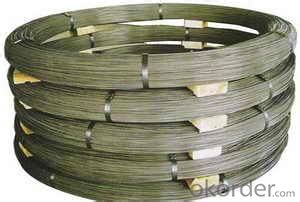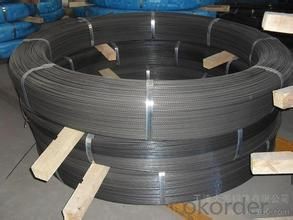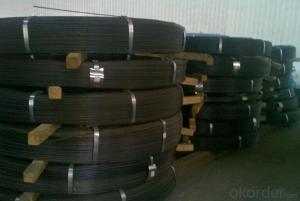Alloy Strand Steel Wire
- Loading Port:
- China Main Port
- Payment Terms:
- TT or LC
- Min Order Qty:
- -
- Supply Capability:
- -
OKorder Service Pledge
OKorder Financial Service
You Might Also Like
Quick Details
| Steel Grade: | SWRH77B, SWRH82B | Standard: | ASTM,BS,GB,JIS | Wire Gauge: | 4.0mm-10.0mm |
| Place of Origin: | Tianjin China (Mainland) | Type: | Drawn Wire,Spiral/Helical Ribs, Round Plain | Application: | Construction |
| Alloy Or Not: | Is Alloy | Special Use: | Free Cutting Steel | Model Number: | 4.0-10.0mm |
| Product Name: | prestressed steel wire 4mm high carbon steel wire | Size: | 4.0-10.0mm | ||
| Strength: | 1570/1670/1770/1860 N/mm2 | Relaxation: | Less than 2% (1000hour) | Elongation: | Not less than 4% |
| MOQ: | 10 Tons | Payment: | TT, LC | Delivery: | 10-15 work days |
| Package: | As your requirements |
Packaging & Delivery
| Packaging Detail:steel strand coil to be packed in damp proof materials strapped with 8 bands on one wooded pallet with an outer layer of plastic used for anti-rainshower 2 or 3 wooden block undermeath each coil. | |
| Delivery Detail:within 2 weeks |
Specifications
high carbon class A steel wire
Constructon:7 steel wire
material:wire 82B
FAQ of Alloy Strand Steel Wire:
①How is the quality of your products?
Our products are manufactured strictly according to national and internaional standard, and we take a test on every pipe before delivered out. Guaranteed: If products’ quality don’t accord to discription as we give or the promise before you place order, we promise 100% refund.
②How about price?
Yes, we are factory and be able to give you lowest price below market one, and we have a policy that “ for saving time and absolutely honest business attitude, we quote as lowest as possible for any customer, and discount can be given according to quantity”,if you like bargain and factory price is not low enough as you think, just don’t waste your time.Please trust the quotation we would give you, it is professional one.
③Why should you chose us?
Chose happens because of quality, then price, We can give you both.Additionally, we can also offer professional products inquiry, products knowledge train(for agents), smooth goods delivery, exellent customer solution proposals.Our service formula: good quality+good price+good service=customer’s trust
SGS test is available, customer inspection before shipping is welcome, third party inspection is no problem.
Any question, pls feel free to contact us !
Alloy Strand Steel Wire Images:


- Q:What are the main factors influencing the choice of steel wire rod surface finish?
- The choice of steel wire rod surface finish is influenced by several factors, each of which plays a significant role in determining the appropriate finish for a particular application. One of the main factors is the intended use of the wire rod. Different surface finishes offer varying levels of corrosion resistance, lubricity, and adhesion properties, which are crucial considerations in determining the suitability of the wire rod for a specific application. For example, a wire rod used in a corrosive environment may require a surface finish that provides enhanced resistance to rust and oxidation. Another factor influencing the choice of surface finish is the desired aesthetic appearance. Certain industries, such as automotive or consumer goods, may have specific requirements for the visual appeal of the wire rod. In such cases, finishes that offer a smooth, polished, or decorative appearance may be preferred. The mechanical properties required for the wire rod's application also play a role in determining the surface finish. Some finishes, such as a bright or polished surface, can improve the wire rod's yield strength, ductility, and fatigue resistance. These properties are vital in applications that involve high-stress conditions or require flexibility and durability. Cost considerations also come into play when selecting the surface finish. Some finishes require additional processing steps, such as pickling, coating, or electroplating, which can increase the overall cost of the wire rod. Therefore, it is essential to balance the desired surface finish with the cost-effectiveness of the manufacturing process. Lastly, environmental and regulatory factors can influence the choice of surface finish. Certain finishes may contain hazardous substances or require specific disposal methods, which can impact the environmental footprint of the wire rod production. Compliance with industry standards and regulations is crucial to ensure the safety and sustainability of the finished product. In conclusion, the choice of steel wire rod surface finish is influenced by factors such as intended use, aesthetic requirements, mechanical properties, cost considerations, and environmental considerations. By carefully considering these factors, manufacturers can select the most appropriate surface finish that aligns with the specific requirements of the application and ensures the optimal performance and quality of the wire rod.
- Q:How is steel wire rod used in the production of wire shelving?
- Steel wire rod is used in the production of wire shelving as the primary raw material. It is first shaped and cut into the desired length and thickness, then bent and welded to form the structure of the shelving. The steel wire rod provides strength, durability, and stability to the shelves, ensuring they can support heavy loads and withstand daily use.
- Q:How is steel wire rod used in the manufacturing of automotive seat frames?
- Steel wire rod is commonly used in the manufacturing of automotive seat frames due to its high strength and durability properties. The steel wire rod is typically formed into different shapes and sizes to create the framework for automotive seats. These seat frames provide structural support and stability to the seats, ensuring they can withstand the weight and movements of passengers. The steel wire rod is first processed through various manufacturing techniques such as hot rolling, cold drawing, and heat treatment to achieve the desired mechanical properties. This process ensures that the steel wire rod has the necessary strength and flexibility to withstand the constant stress and load-bearing requirements of automotive seat frames. Once the steel wire rod is prepared, it is then bent and shaped into the required form using specialized machinery. This allows manufacturers to create different seat frame designs that meet the specific requirements of different vehicle models. The steel wire rod is often welded or joined together at specific points to form a sturdy and stable seat frame structure. The use of steel wire rod in automotive seat frames offers several advantages. Firstly, steel is known for its high strength-to-weight ratio, making it an ideal material for supporting heavy loads without adding excessive weight to the vehicle. Additionally, steel wire rod has excellent corrosion resistance properties, ensuring that seat frames remain durable and long-lasting even in harsh environmental conditions. Moreover, steel wire rod provides flexibility in design and customization. Manufacturers can easily modify the shape and size of the seat frames to accommodate various seat configurations and ergonomic requirements. This allows for the production of comfortable and safe seating options for passengers. In summary, steel wire rod is essential in the manufacturing of automotive seat frames due to its strength, durability, and customization capabilities. It provides the necessary structural support and stability to ensure the safety and comfort of vehicle occupants.
- Q:What are the different straightening methods for steel wire rod?
- There are several different methods for straightening steel wire rods, including rotary straightening, roll straightening, and stretching straightening.
- Q:How is steel wire rod processed to achieve specific properties?
- Steel wire rod is processed through a series of manufacturing steps to achieve specific properties that make it suitable for various applications. The process begins with the selection of high-quality raw materials, typically low carbon steel, which is melted in a furnace to create molten steel. Once the molten steel is produced, it is then continuously cast into billets or blooms, which are solidified and then rolled into wire rod form through hot rolling. This hot rolling process involves passing the billets or blooms through a series of rollers to reduce their size and shape them into the desired wire rod dimensions. This step helps align the grain structure of the steel, improving its strength and ductility. After hot rolling, the wire rod undergoes a cooling process to relieve any residual stress and ensure dimensional stability. It is then subjected to a surface treatment, such as pickling or shot blasting, to remove any oxides or scale formed during the hot rolling process. To achieve specific mechanical properties, the wire rod may undergo further processing steps, such as cold drawing or heat treatment. Cold drawing involves pulling the wire rod through a series of dies to reduce its diameter, increase its tensile strength, and improve its surface finish. Heat treatment, on the other hand, involves subjecting the wire rod to controlled heating and cooling cycles to modify its microstructure, resulting in desired properties like hardness, toughness, or corrosion resistance. Additionally, the wire rod may undergo additional surface treatments, such as coating or galvanizing, to enhance its corrosion resistance or improve its aesthetic appearance. Coating can involve applying a layer of zinc, polymer, or other protective materials, while galvanizing involves immersing the wire rod in a bath of molten zinc to create a protective zinc coating. Overall, the processing of steel wire rod involves a combination of hot rolling, cooling, surface treatment, and potential further processing steps like cold drawing or heat treatment. These steps are carefully implemented to achieve specific properties, such as strength, ductility, corrosion resistance, and surface finish, making the wire rod suitable for diverse applications in industries like construction, automotive, manufacturing, and more.
- Q:What are the main factors influencing the choice of steel wire rod quality standards?
- The quality standards for steel wire rod are determined by various factors. Firstly, the intended use of the wire rod is crucial in determining the appropriate quality standards. Different industries have specific requirements for strength, durability, corrosion resistance, and other mechanical properties. Therefore, the choice of quality standards depends on meeting these specific needs. Secondly, national and international regulations play a significant role in determining the quality standards for steel wire rod. Organizations like ASTM, ISO, and EN regulate these standards to ensure safety and performance requirements are met. Customer specifications also influence the choice of quality standards. Customers may have their own specific requirements for chemical composition, mechanical properties, surface finish, and dimensional tolerances. Meeting these specifications is essential for customer satisfaction and maintaining long-term business relationships. Manufacturers and suppliers of steel wire rod have their own internal quality assurance and control processes. These processes include inspections, testing, and certifications to ensure the wire rod meets the required quality standards. The choice of quality standards is influenced by the manufacturer's ability to meet these internal quality control measures. Additionally, cost considerations play a role in determining the choice of quality standards. Higher quality standards may require more stringent manufacturing processes, testing, and inspections, resulting in higher production costs. Striking a balance between quality and cost is necessary to remain competitive in the market. In conclusion, the choice of steel wire rod quality standards is influenced by application requirements, national and international regulations, customer specifications, quality assurance and control processes, and cost considerations. By considering these factors, manufacturers and customers can select the appropriate quality standards to meet their specific needs and ensure the desired performance and reliability of the steel wire rod.
- Q:What are the common applications of stainless steel wire rod?
- Due to their exceptional properties and versatility, stainless steel wire rods are extensively utilized in various industries. These wire rods have numerous applications in different sectors: 1. In the manufacturing industry, stainless steel wire rods are widely employed for producing a variety of products. They are commonly utilized in the manufacturing of small components like springs, fasteners, screws, bolts, and more. The outstanding tensile strength and corrosion resistance of stainless steel make it an ideal material for such purposes. 2. The construction industry heavily relies on stainless steel wire rods for structural applications. These rods are used to reinforce concrete structures such as bridges, buildings, and tunnels, enhancing their strength and durability. The corrosion resistance of stainless steel makes it suitable for outdoor applications where exposure to moisture and harsh weather conditions is prevalent. 3. The automotive industry extensively utilizes stainless steel wire rods. They are employed in the production of various components including exhaust systems, suspension springs, and engine parts. The high strength and heat resistance of stainless steel make it well-suited for such applications, ensuring longevity and performance even under demanding conditions. 4. In the aerospace industry, stainless steel wire rods are widely employed. They are utilized for manufacturing aircraft components such as cables, fasteners, and landing gear parts. The exceptional strength-to-weight ratio of stainless steel makes it an ideal material for aerospace applications where lightweight and high-performance materials are crucial. 5. The medical industry also benefits from the applications of stainless steel wire rods. These rods are used for manufacturing surgical instruments, orthopedic implants, and medical devices. The biocompatibility and corrosion resistance of stainless steel are crucial properties for such applications, ensuring the safety and durability of medical equipment. 6. The food processing industry extensively utilizes stainless steel wire rods. They are employed in the production of equipment like conveyor belts, sieves, and filters that come into contact with food products. The high corrosion resistance and hygiene properties of stainless steel make it an ideal material for food processing applications, ensuring product safety and compliance with food regulations. In conclusion, the exceptional properties of stainless steel wire rods make them highly versatile and applicable across various industries. Their high strength, corrosion resistance, heat resistance, and biocompatibility enable the manufacturing of a wide range of products, from small components to large-scale structures.
- Q:What are the different types of steel wire rod surface defect analysis tools?
- There are various types of tools used for analyzing surface defects in steel wire rods. Some commonly used tools include visual inspection, magnifying glasses or microscopes for close examination, dye penetrant testing to detect cracks or discontinuities, magnetic particle inspection to identify surface or near-surface defects, and ultrasonic testing to assess internal defects. Additionally, advanced technologies such as laser scanning or digital imaging systems are also employed for precise defect analysis.
- Q:How is steel wire rod straightened and cut to length?
- Steel wire rod is straightened and cut to length using a combination of mechanical and automated processes. Firstly, the wire rod is passed through a series of straightening rolls that apply pressure to remove any bends or kinks, ensuring a straight and uniform shape. Once straightened, the rod is fed into a cutting machine equipped with circular blades or shears, which precisely cut it to the desired length. This process ensures that steel wire rod is efficiently straightened and cut to meet specific requirements in various industries.
- Q:What are the main factors affecting the market certifications of steel wire rod?
- The main factors affecting the market certifications of steel wire rod include the quality and consistency of the product, adherence to industry standards and regulations, compliance with environmental and safety requirements, and the reputation and credibility of the manufacturer. Additionally, market demand and competition, pricing, customer satisfaction, and the overall economic and political situation can also influence the market certifications of steel wire rod.
1. Manufacturer Overview |
|
|---|---|
| Location | |
| Year Established | |
| Annual Output Value | |
| Main Markets | |
| Company Certifications | |
2. Manufacturer Certificates |
|
|---|---|
| a) Certification Name | |
| Range | |
| Reference | |
| Validity Period | |
3. Manufacturer Capability |
|
|---|---|
| a)Trade Capacity | |
| Nearest Port | |
| Export Percentage | |
| No.of Employees in Trade Department | |
| Language Spoken: | |
| b)Factory Information | |
| Factory Size: | |
| No. of Production Lines | |
| Contract Manufacturing | |
| Product Price Range | |
Send your message to us
Alloy Strand Steel Wire
- Loading Port:
- China Main Port
- Payment Terms:
- TT or LC
- Min Order Qty:
- -
- Supply Capability:
- -
OKorder Service Pledge
OKorder Financial Service
Similar products
New products
Hot products
Related keywords



























